"Basta con queste facce da c...", the poster uses a common Italian proverb, "facce da culo" that means "ass-faces" and so in a poster showing her well rounded ass, Ms. D'Abbraccio says, "enough of ass-faced" parliamentarians, vote for a more beautiful face. Embarrassed, the socialist leaders, vain about their 114 year old history, were stuttering their explanations about the poster.
Saturday, 12 April 2008
Italian Election Candidates
"Basta con queste facce da c...", the poster uses a common Italian proverb, "facce da culo" that means "ass-faces" and so in a poster showing her well rounded ass, Ms. D'Abbraccio says, "enough of ass-faced" parliamentarians, vote for a more beautiful face. Embarrassed, the socialist leaders, vain about their 114 year old history, were stuttering their explanations about the poster.
Tuesday, 1 April 2008
Remembering The Massacre of Monte Sole
Thursday, 13 March 2008
Sex and Hypocrisy
Here are two news items from today's newspaper that illustrate this hypocrisy:
In Tehran (Iran), Mr. Reza Zarei, head of the police department for ensuring proper moral conduct in the national capital, was discovered in the company of 6 sex workers. Mr. Zerei had become famous for his harsh stand on what he called "immoral behaviour" and had got arrested hundreds of young persons with this accusation.
In New York (USA), Mr. Eliot Spitzer, the 48 year old Governor of the New York state has been forced to resign because he was using his office money on sex workers. His bill for the prostitutes amounted to 80 thousand US dollars.
In India, persons who moralise are a plenty. Just think of the one in Maharashtra government who had banned the women in dancing bars. When people are so vehement about moralising, I always feel that they have something to hide! So I hope experts of investigative journalism and sleuths should go after such persons to look in their cupboards if there are any hidden skeletons!
And to celebrate openness, have a look at the Italian version of the Naked News that started today. This internet and mobile phone based TV channel has news shows where the newsreaders (strictly women) slowly take off their clothes, while reading the news. Obviously the TV channel is available only for paying clients.
I guess learning or practising Italian with this news channel could be great fun - it would help you in staying awake while studying and increasing your general knowledge. Only problem is too much anything is not so good and probably once you have seen it a few times, you will be plain bored.
***
Tuesday, 11 March 2008
The Tragedy of Being a Sex Symbol
Soon the bus reached the university area and young students filled the bus. I was going through the newspaper I had found my seat, when I suddenly heard a sharp intake of breath close to me. I looked at the newspaper and I understood the reason for the sudden silence around me. I think all the persons around me were looking at the full page ad on the newspaper.
It was an ad of the March issue of a men’s magazine called Max and the picture showed the cover of the magazine with a breath-taking nude young woman. The picture shows the face and the back of the woman clearly while her breast is seen in a silhouette. The girl is Eva Riccobono and is described as the new Italian top model, a new sex symbol.
As I got down from the bus, I took care to take that newspaper with me. Usually I prefer looking at more mature woman but in this picture, Ms. Riccobono does look wonderful.
While walking to home, I was thinking about the tragedy of Ms. Riccobono. When people proclaim you as a sex symbol, when you become famous for your beautiful body, I guess in your head a clock starts ticking like never before.
I think that all professions where your face, your body are the most important part of being you, the pressure must be terrible. The pressure to be thin, to be paranoid about every strand of hair out of place, every little pimple or wrinkle that appears, every bad angle that could show you less than perfect. How long it is going to last, you must be asking yourself.
And when people love you for your body, somehow it means that rest of you is not worth much. Initially you may love being the sex symbol, but soon you must be dreading it and hating it as much as you love it. Not that I was ever a sex symbol so that I can speak about the feelings of a sex symbol, but you only need to look around at all those beautiful people and how they all, sooner or later, try to show that they are not all body and beauty, that gives you an idea of how they feel.
So many of them become a recluse as their bodies start to age. Like Brigitte Bardot. There was a time, she was the epitome of sex symbols.
And then she hid, closed herself in baggy clothes, huge sunglasses and floppy hats, trying to become invisible. Finally she did find redemption in her love for animals and found the courage to come out and be herself. Look at her older pictures and you realise that she is still wonderfully beautiful, even if it is a different kind of beauty, more gentle and relaxed.
Some of them never find the courage to come out, like Greta Garbo, who lived her life behind closed doors and died in her solitude.
More closer to home we have our Rekha. Look at her pictures from twenty years ago and now, she still looks young and beautiful and yet in a way, a caricature of herself. Even as a grandmother in films like Krissh, she continues to be a young woman dressed as a granny.
Relax Rekha ji, we would still like you even if you let yourself go and relax a little bit. It is ok even if you are not perfect always, chill and enjoy. Yet, once you are prisoner of your image, I guess that it requires lot of courage to come out into open.
So don’t be jealous of these moments of glory of Eva Riccobono. She is sure to earn millions but she is also going to pay a heavy price for it. So best of luck Ms. Riccobono. Once the party is over, I hope you will have the courage to come out and be yourself.
***
Tuesday, 26 February 2008
Sex and the Gods
The entrance and the first glimpse of the ruins of the sun temple built around 1250 AD under king Narsimha with a tinge of morning mist was breath-taking.
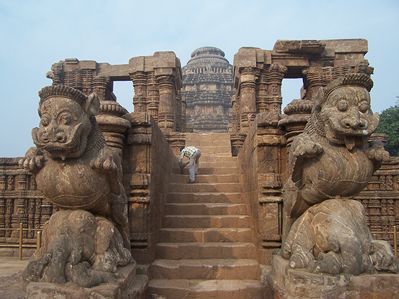
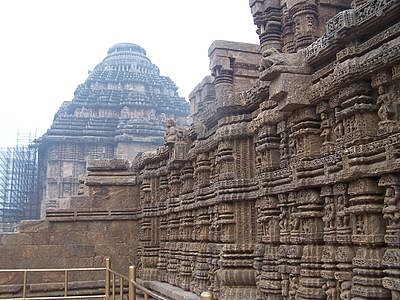
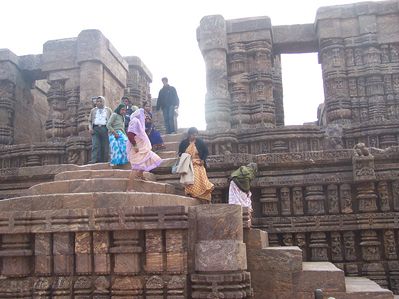
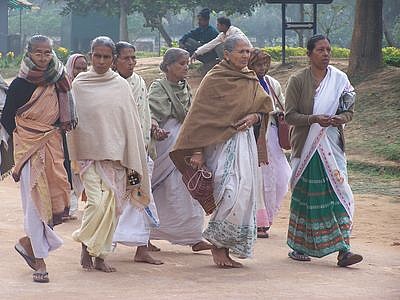
While the beautiful statues at the initial part of the Konark temple are innocuous enough, the main temple building does not leave much doubts about its sexual component with huge erotic sculptures built high up from the ground, around what was the main entrance to the temple. Only if you look carefully you will see a number of smaller erotic sculptures around the big ones.
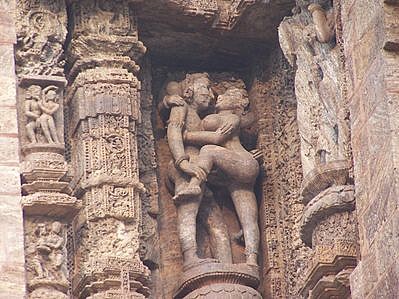
The sidewalls of the temple has smaller statues at eye level, organised in three panels. Most of the lower panels and middle panels do not have erotic sculptures and have more innocuous gods, mythical animals and other figures. Erotic sculptures are mainly in the third level of panels. Dr Mani says that this was done in a way so that children coming to the temple will mainly see non erotic sculptures.
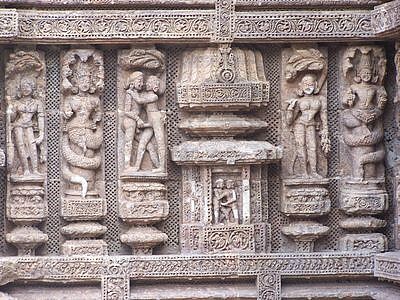
The sculptures are very explicit, depicting graphically the different ways of sexual enjoyment. There is oral sex including "69", there are old looking men and women, there are younger looking men and women, mostly couples but sometimes three figures (one man and two women) are also there together looking for orgasm.
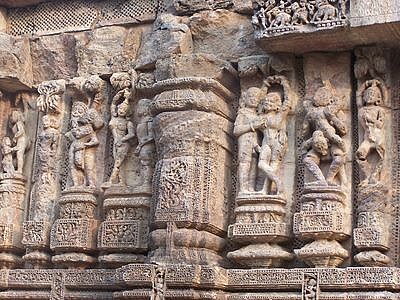
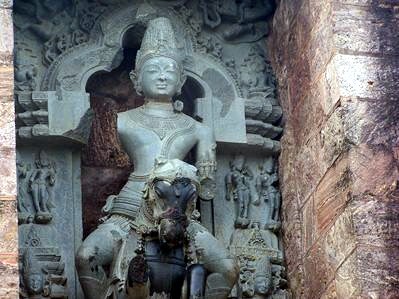
The whole temple is made like a chariot with twelve wheels, symbolising the twelve months of the year, pulled by seven horses, representing the seven days of the week. The wheels, the statues, the carvings, the architecture, everything is exquisite.
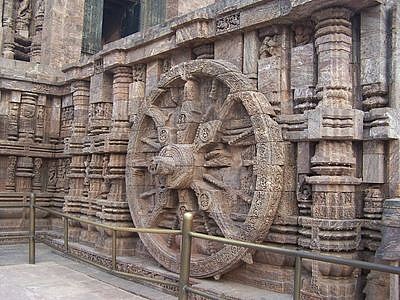
Thinking about the sense of shame usually associated with anything to do with sex, I was wondering about the impact of these erotic statues on the common pilgrims and school students. However, my impression was that barring a few men, who did look towards these panels from a distance, most of the pilgrims kept their heads down and took only fleeting glimpses of the erotic sculptures.
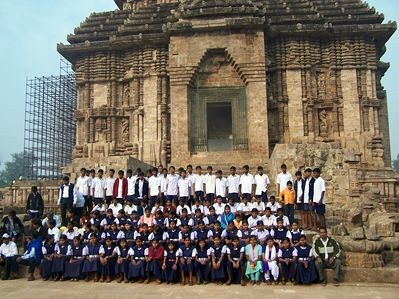
Why did those thirteenth century persons make these erotic sculptures in their temples?
***
Wednesday, 23 January 2008
Describing India - Akbar and Roy
India is the world’s latest quotation mark. Nepal has become a question mark, Sri Lanka an oversized exclamation mark; and Bangladesh is imprisoned between brackets, the space for leeway decreasing by the day. Pakistan is teetering towards a full stop. China has turned into yesterday’s paragraph: still impressive, but with the contradictions becoming evident through cracks separating sentences.
What a wonderful feeling to be an Indian at that moment in history when the world begins to applaud as India comes within reach of that long-promised tryst with destiny, and shifts imperceptibly towards the centre of the stage.
And last night, I was reading the article by Amira Hass on Arundhati Roy in the Italian magazine, Internazionale. And, I was thinking about the differences in their view points, between the India described by M. J. Akbar and that described by Arundhati Roy. They do not seem to be talking about the same country.
Amira is an Isreali journalist, one who lives in Palestine and writes about the Palestinian human rights. I can imagine that she must be seeing and reporting on things and situations that can't be ever described as happy and optimistic. Yet, even she seemed a little afraid of the sense of darkness and doom in Arundhati Roy's words. Or, may be, it was me, reading between the lines and imagining things that are not there.
But it is true, reading Ms. Roy is not easy, especially when we are used to the shining and glowing descriptions of India as exemplified by the words of M. J. Akbar above. Reading Arundhati or listening to her speak, I often feel that she is a very negative person, looking only on negative side of things, yet, I also understand that the unpleasant things she says do have grains of truth in them that we often refuse to acknowledge because they are so unpleasant.
Both Arundhati and Amira were in Ferrara (Italy) for a conference in early October. I had already written about Arundhati's speech in that occasion. She had mentioned about the evening spent with Amira and how much she had enjoyed it.
Here are a few examples fromAmira's article about Arundhati Roy's views during her interview (my translation from Italian):
"The cruelty, in some way, is hidden by discourses on Gandhi, about the country where everyone meditates and does yoga. Oh yes, everything is going well, we play cricket, we elect Miss world and win Booker prize, we even have dissent, what a beautiful happy family. Instead no. The country is passing through dark and cruel times and you know what I tell you? That if we close our eyes, they will become darker and even more cruel. India does not have scruples of killings.
A million persons, the Dalits, the untouchables, still work in direct contact with excretions and what is tragic is that they are willing to fight for their right to work with human excretions, because they don't know what other work they can do. Everyday Dalits are lynched but no one accuses the persons responsible for this. In all of India killings of Muslims continue. In the last years 137 thousand farmers have committed suicide. Only in Kashmir, 60 to 80 thousand persons have been killed ...
In the middle of the country, there is a proper civil war going on. Now they have discovered those damned mines of Bauxite in the states of Orissa and Chhattisgarh, that is used for making Aluminium and the multinationals are doing everything to exploit it. You have to see what they are doing, bringing down whole forests, removing hills, deviating rivers, devastating the earth and forcibly evicting the inhabitants..."
Is Arundhati exaggerating or is Akbar talking about illusions? Probably the truth lies a little on both sides. Persons like Arundhati, I guess that it is not so pleasant to listen to them. Like for me. I would rather listen to Akbar any day.
Even Arundhati does not have any illusions about the persons for whom she raises her voice. "If at the end of so many battles, we shall win, the persons whom we are defending, you will see, those same persons will be the ones to first hang people like us on a tree. I am talking about Maoists and Islamists of Kashmir: at times we take sides of persons, who do not have place for us in their imaginations."
This last part of her words was not understandable to me. When we know that they are brutal exploiters, we need to fight for their right and ask that they become in control of people's lives? What does it mean to talk about the rights of Islamists and Maoists that she is advocating? When the butcher is standing next to the goats, he is going to kill, how can she talk of the rights of the butchers?
I feel that Arundhati uses her eloquence and her beautiful words full of raw emotional power to propose something which is opposite of sanity, it is a sickness.
*****
Sunday, 20 January 2008
Overdose of writers
It was wonderful to meet so many writers from India, to interact with them, to learn about them as persons and a little bit about their creative way of working, the differences among them, their individuality and their conflicts, their fears, their pet phrases.
Now I need to be quiet and calm for some time to digest all that I heard and saw.
I spoke to almost all of them individually about their books and writings (except for Shashi Tharoor, M. J. Akbar and Vikas Swarup). However, I did speak with Shashi Tharoor in the bus-ride as we went to see an opera (Rigoletto).
I had long chat with Bhagwan Dass Morwal right on the first day. With Uday Prakash, there was lot of interaction and somehow, I found myself contradicting him often, perhaps to provoke him! Gayathri Murthy seemed to be familiar right from the first moment, while Nirpal Singh Dhaliwal, initially thought that I won't like him but later, I changed my mind.
I also had some morning conversations with Tarun Tejpal, Lavanya Shankaran, Anita Nair and Altaf Tyrewalla. I specially liked Altaf. It was also nice to sit with Sudhir Kakkar during a lunch.
One of the most interesting discussions we had was during a lunch break with an Iraqi journalist living in Italy, a Singaporean journalist of Indian origin married in Italy (a coincidence that she knew my sister in Delhi) and Nirpal Singh, a writer of Indian origin living in UK. The discussion about our mixed identities, our roots, our families, our feelings and the absurdities of our worlds, was both moving and challenging.
Apart from Indian writers, it was a wonderful opportunity to meet some of the well known writers from all over the world. I have loved reading books of Luis Sepulveda and Tahar Ben Jaloun and meeting them, listening to them was wonderful.
Some others like Rosetta Loy, Peter Schneider, Bjorn Larsson, Alain Elkann, Gianni Riotta, Lorenzo Mondo, Francesca San Vitale, I knew less well because I had never read their works, but after knowing them, I am going to read them too.
Only Federico Rampini, I missed. I was looking forward to listen to him and to get him sign a copy of his book for me but when he spoke, I was busy giving an interview. Afterwards, when I went out to look for him, he was busy in an interview.
Listening to Prof. Sanpietro and his wonderful wife, Myra as well as Prof. Alessandro Monti was equally rewarding. Interviews, speeches, long lunches, longer dinners, an evening at Rigoletto and meeting so many persons, you can understand my sense of indigestion.
I have recorded many of my discussions with the Indian writers, so perhaps one day I will be finish transcribing all of them for you.
I was introduced in the event as an "Indian blogger-writer living in Italy", which made me feel as if I was not a real writer. However, in the end, we are all writing, so I guess that I can also call myself as a writer!
***
This Year's Popular Posts
-
Before coming to Assam in the north-east of India, I had never thought of Shiva and Kali as a couple and I had also never thought of the two...
-
Note (2022) : I had written this post in 2006, to share my own ragging experiences. It is about my positive experiences of ragging in earl...
-
A visit to the Jan Jaati Sanghralaya (Tribal Museum) of Bhopal (Madhya Pradesh, India) brought back the memories of my childhood. If anyone...
-
This post has been published by me as a part of the Blog-a-Ton 22 ; the twenty-second edition of the online marathon of Bloggers; where w...
-
A Scotsman, Robert Bruce is credited with the “discovery” of tea in Assam in India. I think that it is anachronistic that 70 years after the...
-
Last year I visited some beautiful places in Bundelkhand in central India. However, you won't find "Bundelkhand" on the map of...
-
Recently I was reading the wonderful book Sapiens: A Brief History of Humankind by the Israeli writer Yuval Noah Harari (originally writte...
-
When suddenly you start noticing coincidences, does it mean something? Let me give you three examples of three recent coincidences, which ...
-
Finally I am ready to start with my Guwahati city walks – discovering this city through easy walking tours. For the first Guwahati tour I h...
-
" Why don't you make a film on the issue of disability and sexuality? ", I had asked Arun while we were out on a walk. After ...
















